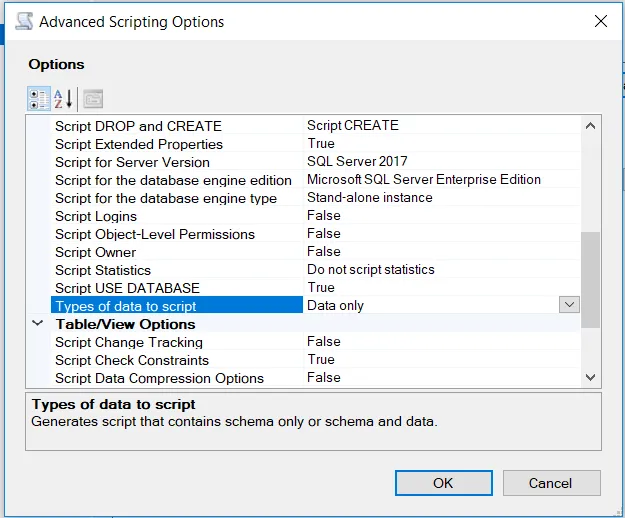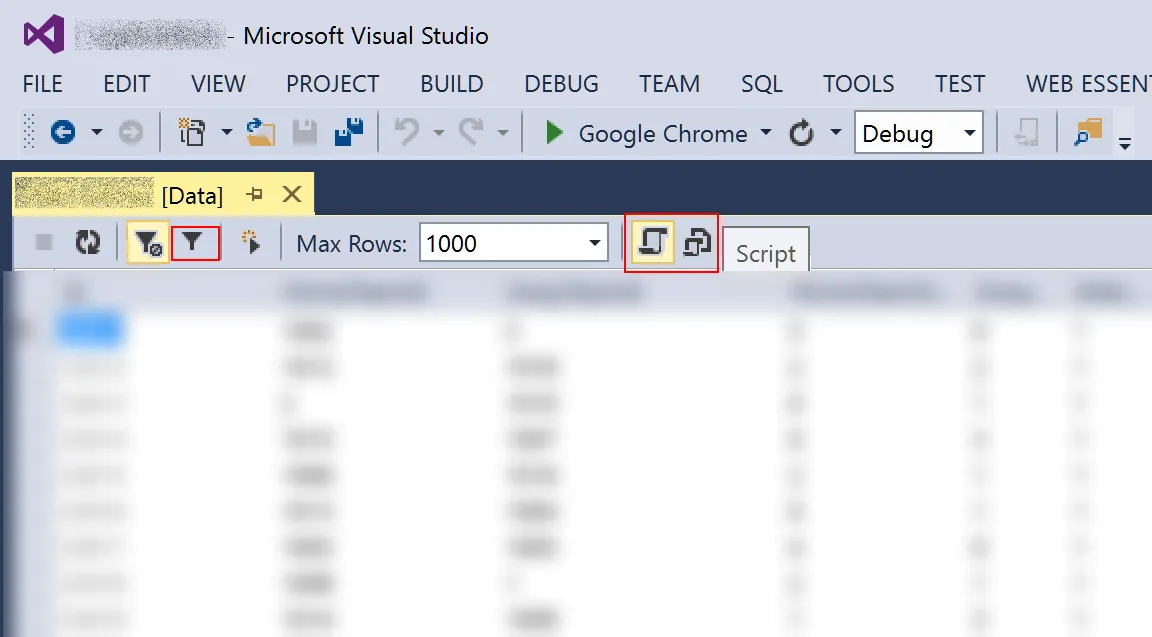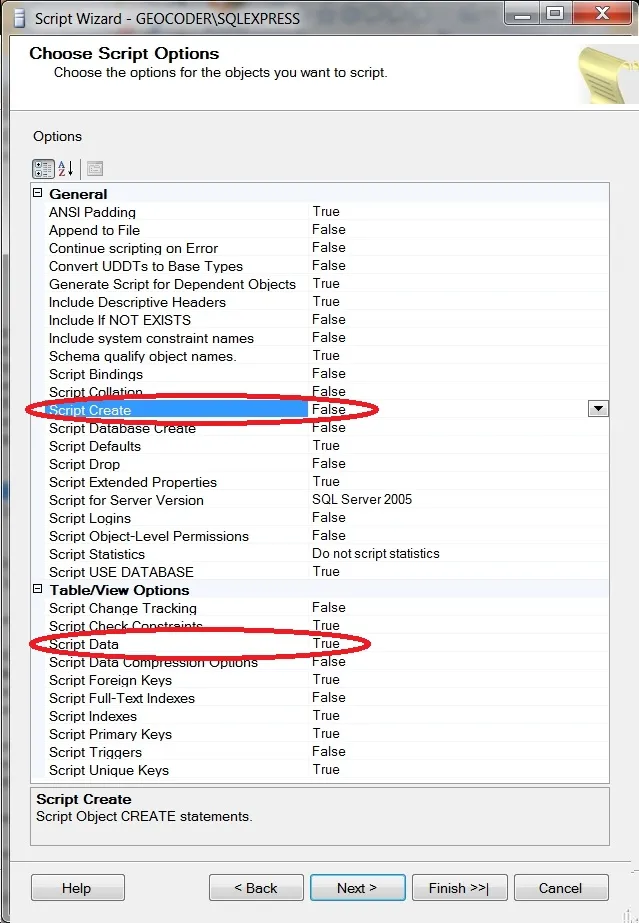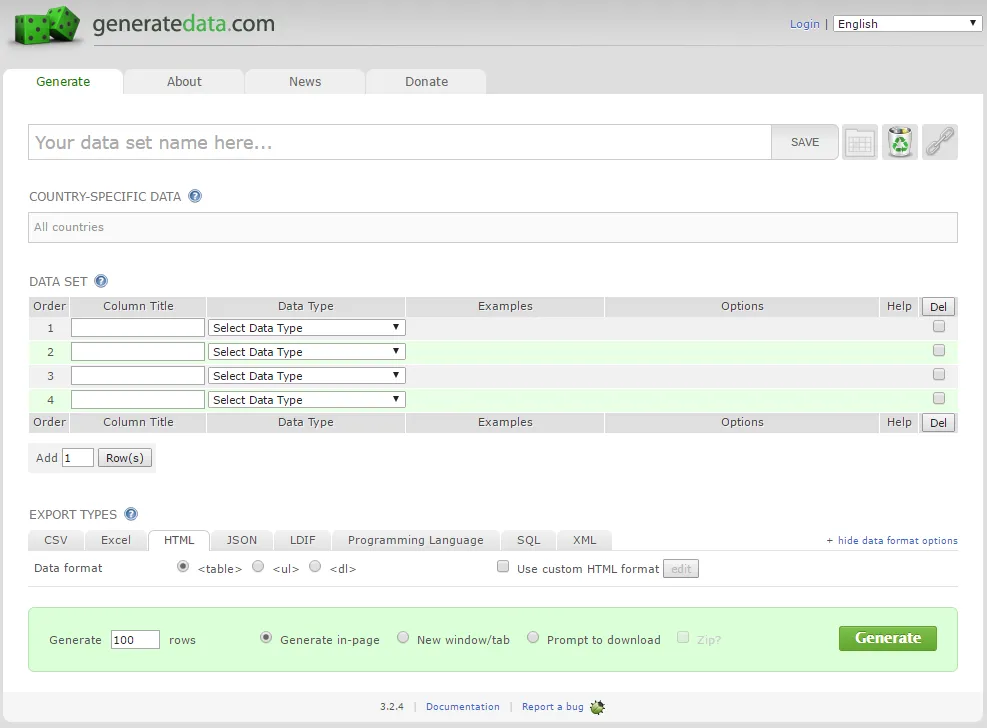我们使用这个存储过程 - 它允许你针对特定的表,并使用where子句。你可以在这里找到文本。
例如,它可以让你做到这一点:
EXEC sp_generate_inserts 'titles'
从链接复制的源代码:
SET NOCOUNT ON
GO
PRINT 'Using Master database'
USE master
GO
PRINT 'Checking for the existence of this procedure'
IF (SELECT OBJECT_ID('sp_generate_inserts','P')) IS NOT NULL
BEGIN
PRINT 'Procedure already exists. So, dropping it'
DROP PROC sp_generate_inserts
END
GO
EXEC master.dbo.sp_MS_upd_sysobj_category 1
GO
CREATE PROC sp_generate_inserts
(
@table_name varchar(776),
@target_table varchar(776) = NULL,
@include_column_list bit = 1,
@from varchar(800) = NULL,
@include_timestamp bit = 0,
@debug_mode bit = 0,
@owner varchar(64) = NULL,
@ommit_images bit = 0,
@ommit_identity bit = 0,
@top int = NULL,
@cols_to_include varchar(8000) = NULL,
@cols_to_exclude varchar(8000) = NULL,
@disable_constraints bit = 0,
@ommit_computed_cols bit = 0
)
AS
BEGIN
SET NOCOUNT ON
IF ((@cols_to_include IS NOT NULL) AND (@cols_to_exclude IS NOT NULL))
BEGIN
RAISERROR('Use either @cols_to_include or @cols_to_exclude. Do not use both the parameters at once',16,1)
RETURN -1
END
IF ((@cols_to_include IS NOT NULL) AND (PATINDEX('''%''',@cols_to_include) = 0))
BEGIN
RAISERROR('Invalid use of @cols_to_include property',16,1)
PRINT 'Specify column names surrounded by single quotes and separated by commas'
PRINT 'Eg: EXEC sp_generate_inserts titles, @cols_to_include = "''title_id'',''title''"'
RETURN -1
END
IF ((@cols_to_exclude IS NOT NULL) AND (PATINDEX('''%''',@cols_to_exclude) = 0))
BEGIN
RAISERROR('Invalid use of @cols_to_exclude property',16,1)
PRINT 'Specify column names surrounded by single quotes and separated by commas'
PRINT 'Eg: EXEC sp_generate_inserts titles, @cols_to_exclude = "''title_id'',''title''"'
RETURN -1
END
IF (PARSENAME(@table_name,3)) IS NOT NULL
BEGIN
RAISERROR('Do not specify the database name. Be in the required database and just specify the table name.',16,1)
RETURN -1
END
IF @owner IS NULL
BEGIN
IF ((OBJECT_ID(@table_name,'U') IS NULL) AND (OBJECT_ID(@table_name,'V') IS NULL))
BEGIN
RAISERROR('User table or view not found.',16,1)
PRINT 'You may see this error, if you are not the owner of this table or view. In that case use @owner parameter to specify the owner name.'
PRINT 'Make sure you have SELECT permission on that table or view.'
RETURN -1
END
END
ELSE
BEGIN
IF NOT EXISTS (SELECT 1 FROM INFORMATION_SCHEMA.TABLES WHERE TABLE_NAME = @table_name AND (TABLE_TYPE = 'BASE TABLE' OR TABLE_TYPE = 'VIEW') AND TABLE_SCHEMA = @owner)
BEGIN
RAISERROR('User table or view not found.',16,1)
PRINT 'You may see this error, if you are not the owner of this table. In that case use @owner parameter to specify the owner name.'
PRINT 'Make sure you have SELECT permission on that table or view.'
RETURN -1
END
END
DECLARE @Column_ID int,
@Column_List varchar(8000),
@Column_Name varchar(128),
@Start_Insert varchar(786),
@Data_Type varchar(128),
@Actual_Values varchar(8000),
@IDN varchar(128)
SET @IDN = ''
SET @Column_ID = 0
SET @Column_Name = ''
SET @Column_List = ''
SET @Actual_Values = ''
IF @owner IS NULL
BEGIN
SET @Start_Insert = 'INSERT INTO ' + '[' + RTRIM(COALESCE(@target_table,@table_name)) + ']'
END
ELSE
BEGIN
SET @Start_Insert = 'INSERT ' + '[' + LTRIM(RTRIM(@owner)) + '].' + '[' + RTRIM(COALESCE(@target_table,@table_name)) + ']'
END
SELECT @Column_ID = MIN(ORDINAL_POSITION)
FROM INFORMATION_SCHEMA.COLUMNS (NOLOCK)
WHERE TABLE_NAME = @table_name AND
(@owner IS NULL OR TABLE_SCHEMA = @owner)
WHILE @Column_ID IS NOT NULL
BEGIN
SELECT @Column_Name = QUOTENAME(COLUMN_NAME),
@Data_Type = DATA_TYPE
FROM INFORMATION_SCHEMA.COLUMNS (NOLOCK)
WHERE ORDINAL_POSITION = @Column_ID AND
TABLE_NAME = @table_name AND
(@owner IS NULL OR TABLE_SCHEMA = @owner)
IF @cols_to_include IS NOT NULL
BEGIN
IF CHARINDEX( '''' + SUBSTRING(@Column_Name,2,LEN(@Column_Name)-2) + '''',@cols_to_include) = 0
BEGIN
GOTO SKIP_LOOP
END
END
IF @cols_to_exclude IS NOT NULL
BEGIN
IF CHARINDEX( '''' + SUBSTRING(@Column_Name,2,LEN(@Column_Name)-2) + '''',@cols_to_exclude) <> 0
BEGIN
GOTO SKIP_LOOP
END
END
IF (SELECT COLUMNPROPERTY( OBJECT_ID(QUOTENAME(COALESCE(@owner,USER_NAME())) + '.' + @table_name),SUBSTRING(@Column_Name,2,LEN(@Column_Name) - 2),'IsIdentity')) = 1
BEGIN
IF @ommit_identity = 0
SET @IDN = @Column_Name
ELSE
GOTO SKIP_LOOP
END
IF @ommit_computed_cols = 1
BEGIN
IF (SELECT COLUMNPROPERTY( OBJECT_ID(QUOTENAME(COALESCE(@owner,USER_NAME())) + '.' + @table_name),SUBSTRING(@Column_Name,2,LEN(@Column_Name) - 2),'IsComputed')) = 1
BEGIN
GOTO SKIP_LOOP
END
END
IF(@Data_Type in ('image'))
BEGIN
IF (@ommit_images = 0)
BEGIN
RAISERROR('Tables with image columns are not supported.',16,1)
PRINT 'Use @ommit_images = 1 parameter to generate INSERTs for the rest of the columns.'
PRINT 'DO NOT ommit Column List in the INSERT statements. If you ommit column list using @include_column_list=0, the generated INSERTs will fail.'
RETURN -1
END
ELSE
BEGIN
GOTO SKIP_LOOP
END
END
SET @Actual_Values = @Actual_Values +
CASE
WHEN @Data_Type IN ('char','varchar','nchar','nvarchar')
THEN
'COALESCE('''''''' + REPLACE(RTRIM(' + @Column_Name + '),'''''''','''''''''''')+'''''''',''NULL'')'
WHEN @Data_Type IN ('datetime','smalldatetime')
THEN
'COALESCE('''''''' + RTRIM(CONVERT(char,' + @Column_Name + ',109))+'''''''',''NULL'')'
WHEN @Data_Type IN ('uniqueidentifier')
THEN
'COALESCE('''''''' + REPLACE(CONVERT(char(255),RTRIM(' + @Column_Name + ')),'''''''','''''''''''')+'''''''',''NULL'')'
WHEN @Data_Type IN ('text','ntext')
THEN
'COALESCE('''''''' + REPLACE(CONVERT(char(8000),' + @Column_Name + '),'''''''','''''''''''')+'''''''',''NULL'')'
WHEN @Data_Type IN ('binary','varbinary')
THEN
'COALESCE(RTRIM(CONVERT(char,' + 'CONVERT(int,' + @Column_Name + '))),''NULL'')'
WHEN @Data_Type IN ('timestamp','rowversion')
THEN
CASE
WHEN @include_timestamp = 0
THEN
'''DEFAULT'''
ELSE
'COALESCE(RTRIM(CONVERT(char,' + 'CONVERT(int,' + @Column_Name + '))),''NULL'')'
END
WHEN @Data_Type IN ('float','real','money','smallmoney')
THEN
'COALESCE(LTRIM(RTRIM(' + 'CONVERT(char, ' + @Column_Name + ',2)' + ')),''NULL'')'
ELSE
'COALESCE(LTRIM(RTRIM(' + 'CONVERT(char, ' + @Column_Name + ')' + ')),''NULL'')'
END + '+' + ''',''' + ' + '
SET @Column_List = @Column_List + @Column_Name + ','
SKIP_LOOP:
SELECT @Column_ID = MIN(ORDINAL_POSITION)
FROM INFORMATION_SCHEMA.COLUMNS (NOLOCK)
WHERE TABLE_NAME = @table_name AND
ORDINAL_POSITION > @Column_ID AND
(@owner IS NULL OR TABLE_SCHEMA = @owner)
END
SET @Column_List = LEFT(@Column_List,len(@Column_List) - 1)
SET @Actual_Values = LEFT(@Actual_Values,len(@Actual_Values) - 6)
IF LTRIM(@Column_List) = ''
BEGIN
RAISERROR('No columns to select. There should at least be one column to generate the output',16,1)
RETURN -1
END
IF (@include_column_list <> 0)
BEGIN
SET @Actual_Values =
'SELECT ' +
CASE WHEN @top IS NULL OR @top < 0 THEN '' ELSE ' TOP ' + LTRIM(STR(@top)) + ' ' END +
'''' + RTRIM(@Start_Insert) +
' ''+' + '''(' + RTRIM(@Column_List) + '''+' + ''')''' +
' +''VALUES(''+ ' + @Actual_Values + '+'')''' + ' ' +
COALESCE(@from,' FROM ' + CASE WHEN @owner IS NULL THEN '' ELSE '[' + LTRIM(RTRIM(@owner)) + '].' END + '[' + rtrim(@table_name) + ']' + '(NOLOCK)')
END
ELSE IF (@include_column_list = 0)
BEGIN
SET @Actual_Values =
'SELECT ' +
CASE WHEN @top IS NULL OR @top < 0 THEN '' ELSE ' TOP ' + LTRIM(STR(@top)) + ' ' END +
'''' + RTRIM(@Start_Insert) +
' '' +''VALUES(''+ ' + @Actual_Values + '+'')''' + ' ' +
COALESCE(@from,' FROM ' + CASE WHEN @owner IS NULL THEN '' ELSE '[' + LTRIM(RTRIM(@owner)) + '].' END + '[' + rtrim(@table_name) + ']' + '(NOLOCK)')
END
IF @debug_mode =1
BEGIN
PRINT '/*****START OF DEBUG INFORMATION*****'
PRINT 'Beginning of the INSERT statement:'
PRINT @Start_Insert
PRINT ''
PRINT 'The column list:'
PRINT @Column_List
PRINT ''
PRINT 'The SELECT statement executed to generate the INSERTs'
PRINT @Actual_Values
PRINT ''
PRINT '*****END OF DEBUG INFORMATION*****/'
PRINT ''
END
PRINT '--INSERTs generated by ''sp_generate_inserts'' stored procedure written by Vyas'
PRINT '--Build number: 22'
PRINT '--Problems/Suggestions? Contact Vyas @ vyaskn@hotmail.com'
PRINT '--http://vyaskn.tripod.com'
PRINT ''
PRINT 'SET NOCOUNT ON'
PRINT ''
IF (@IDN <> '')
BEGIN
PRINT 'SET IDENTITY_INSERT ' + QUOTENAME(COALESCE(@owner,USER_NAME())) + '.' + QUOTENAME(@table_name) + ' ON'
PRINT 'GO'
PRINT ''
END
IF @disable_constraints = 1 AND (OBJECT_ID(QUOTENAME(COALESCE(@owner,USER_NAME())) + '.' + @table_name, 'U') IS NOT NULL)
BEGIN
IF @owner IS NULL
BEGIN
SELECT 'ALTER TABLE ' + QUOTENAME(COALESCE(@target_table, @table_name)) + ' NOCHECK CONSTRAINT ALL' AS '--Code to disable constraints temporarily'
END
ELSE
BEGIN
SELECT 'ALTER TABLE ' + QUOTENAME(@owner) + '.' + QUOTENAME(COALESCE(@target_table, @table_name)) + ' NOCHECK CONSTRAINT ALL' AS '--Code to disable constraints temporarily'
END
PRINT 'GO'
END
PRINT ''
PRINT 'PRINT ''Inserting values into ' + '[' + RTRIM(COALESCE(@target_table,@table_name)) + ']' + ''''
EXEC (@Actual_Values)
PRINT 'PRINT ''Done'''
PRINT ''
IF @disable_constraints = 1 AND (OBJECT_ID(QUOTENAME(COALESCE(@owner,USER_NAME())) + '.' + @table_name, 'U') IS NOT NULL)
BEGIN
IF @owner IS NULL
BEGIN
SELECT 'ALTER TABLE ' + QUOTENAME(COALESCE(@target_table, @table_name)) + ' CHECK CONSTRAINT ALL' AS '--Code to enable the previously disabled constraints'
END
ELSE
BEGIN
SELECT 'ALTER TABLE ' + QUOTENAME(@owner) + '.' + QUOTENAME(COALESCE(@target_table, @table_name)) + ' CHECK CONSTRAINT ALL' AS '--Code to enable the previously disabled constraints'
END
PRINT 'GO'
END
PRINT ''
IF (@IDN <> '')
BEGIN
PRINT 'SET IDENTITY_INSERT ' + QUOTENAME(COALESCE(@owner,USER_NAME())) + '.' + QUOTENAME(@table_name) + ' OFF'
PRINT 'GO'
END
PRINT 'SET NOCOUNT OFF'
SET NOCOUNT OFF
RETURN 0
END
GO
PRINT 'Created the procedure'
GO
EXEC master.dbo.sp_MS_upd_sysobj_category 2
GO
PRINT 'Granting EXECUTE permission on sp_generate_inserts to all users'
GRANT EXEC ON sp_generate_inserts TO public
SET NOCOUNT OFF
GO
PRINT 'Done'



